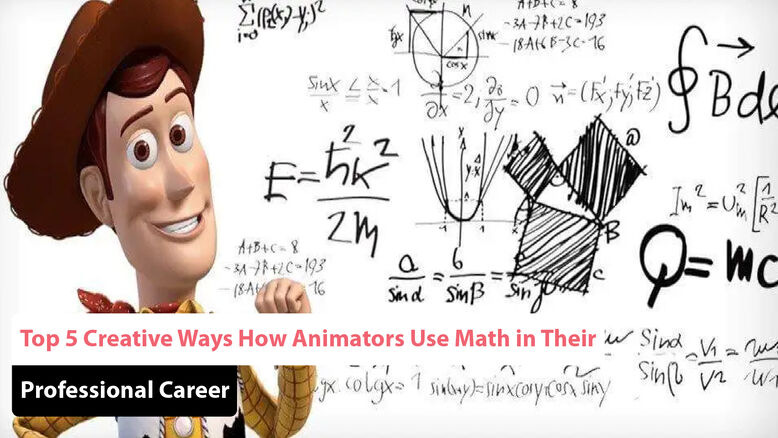
Animation is often perceived as a purely artistic field. While creativity and storytelling are at its core, math plays a crucial role in bringing those imaginative worlds to life. In 2025, the lines between technology and art have never been more blurred, and understanding math has become a superpower for modern animators.
From smooth character movement to lifelike simulations, behind every scene lies a network of calculations. Whether you’re an aspiring animator or a professional sharpening your toolkit, it’s important to understand how animators use math in animation.
This blog explores the top 5 creative ways animators use math in their careers today and how these techniques shape both 2D and 3D animation workflows. We’ll also break down:
- Core mathematical concepts in animation
- The role of geometry in animation design
- Applications of calculus, algebra, and physics in animation
- Real-world math techniques for 2D and 3D animation
Let’s dive into the fascinating numbers behind the magic of motion.
1. Geometry: The Foundation of Animation Design
One of the most fundamental mathematical concepts in animation is geometry. Shapes, curves, and spatial relationships are all built upon geometric principles.
Where Geometry Appears in Animation:
- Modeling characters and environments
- Defining paths and motion curves
- Designing 2D rigging systems and skeletal structures
- Creating symmetry and perspective
In 3D animation, every model is a mesh composed of vertices, edges, and faces—all geometric elements. Animators use polygonal modeling, where geometry defines the structure and detail of characters and props. When creating motion paths, Bezier and spline curves—key elements of geometry—are used to define how an object moves across time and space.
This highlights the vital role of geometry in animation design, especially for artists working in modeling, layout, and rigging.
2. Calculus: Bringing Smooth and Natural Motion to Life
If geometry builds the shapes, calculus brings them to life. Calculus plays a major role in creating fluid and realistic motion.
How Calculus is Used in Animation:
- Simulating acceleration, deceleration, and inertia
- Describing the rate of change in movement
- Crafting realistic curves of motion
- Smooth interpolation between frames
In essence, calculus allows animators to predict how things move over time—key to simulating bouncing balls, walking characters, or even flying dragons.
For example, velocity (change in position over time) and acceleration (change in velocity over time) are both derivatives—central to the mathematics behind realistic animation effects.
Most modern animation software automatically calculates this using curve editors. However, understanding these principles helps animators make informed adjustments for more lifelike animations.
Whether animating camera pans or action-packed fight scenes, calculus is at the heart of believable, physics-based animation.
3. Algebra: The Core of Control Systems and Rigging
Beyond motion, algebra applications in the animation industry are extensive, especially in creating rigs, controls, and logical animation behaviors.
How Algebra Powers Animation:
- Controlling character rig behavior with equations
- Programming sliders and drivers (e.g., jaw open = blend shape value)
- Implementing conditionals and constraints in rigging
For instance, if a character’s leg moves forward, algebraic equations calculate how the knee bends or how the foot should rotate. Drivers and expressions use basic algebra to manipulate multiple body parts through a single control, which greatly speeds up the animator’s workflow.
Algebra also appears in shader development, materials, and procedural animation, where variables and expressions determine dynamic changes in the scene.
So while you might not be solving equations by hand, understanding variable relationships makes you a more powerful and adaptable animator.
4. Physics and Math in Computer Animation
The real world doesn’t move in perfect straight lines or rigid patterns. To simulate natural phenomena, animators rely on a combination of physics and math in computer animation.
Examples of Math-Driven Physical Effects:
- Gravity (falling objects)
- Friction (rolling or sliding)
- Collision detection and response
- Soft body and cloth simulations
Using Newtonian physics and numerical methods, simulation tools allow animators to mimic the real world in astonishing detail. In 2025, animators frequently use math-based simulation systems to create dynamic water, fire, explosions, hair, and cloth.
For example, when animating a character diving into water, math equations calculate the force of impact, water displacement, and the splash. These are often built into tools like Houdini, Maya’s Bifrost, or Blender’s Physics Engine.
Without a firm understanding of the mathematical laws behind motion, animators risk creating scenes that look “off” to the audience.
5. Mathematical Techniques in 2D and 3D Animation Pipelines
Whether working in 2D or 3D, animators use a set of core math techniques for 2D and 3D animation in every part of the production pipeline.
For 2D Animation:
- Tweening with keyframe interpolation
- Path-based animation (e.g., circular or arc motion)
- Timing charts and exposure sheets (frame-based math)
For 3D Animation:
- Kinematics (FK/IK systems)
- Motion graphs and curves
- Rotation matrices and transformations
A simple walk cycle can involve vector math to define direction, matrices to handle joint rotation, and trigonometry to simulate pendulum-like motion.
Even camera movements use math for perspective, field of view, and parallax calculations.
Whether animating characters, designing UI animations, or creating motion graphics, these are essential mathematical concepts in animation that help maintain consistency and realism.
Bonus: Procedural Animation and Code-Based Motion
With the rise of real-time rendering and interactive platforms in 2025, many animators are now incorporating code-based animation using math-driven logic.
Languages like Python and JavaScript allow artists to:
- Generate procedural motion (e.g., waves, trails, or particle bursts)
- Automate repetitive animation tasks
- Create tools for animation studios
These systems often use mathematical functions (like sine waves, noise functions, or decay curves) to drive subtle variations or automate effects.
If you’re aiming for a career in technical animation or visual effects, diving into math and code is now more valuable than ever.
Top Software Animators Use for Math-Based Animation in 2025
Here are the top tools animators use today that blend creativity with computation:
| Software | Purpose | Math Involved |
|---|---|---|
| Autodesk Maya | 3D Animation, Rigging, Simulation | Algebra, Calculus, Physics |
| Blender | 3D Modeling, Rigging, Physics | Geometry, Trigonometry, Graph Theory |
| Toon Boom Harmony | 2D Animation | Interpolation, Frame Timing |
| Adobe After Effects | Motion Graphics, VFX | Keyframe Interpolation, Graph Curves |
| SideFX Houdini | Procedural FX and Simulations | Vector Math, Scripting, Physics |
| Unity & Unreal Engine | Game Animation & Real-Time Engines | Kinematics, Vectors, Real-Time Physics |
All of these tools depend heavily on underlying math, often abstracted away from the user but available for control by those who seek deeper influence.
Why Math Is More Important Than Ever in Animation
1. It Improves Problem Solving
When you understand the math behind your tools, you can solve animation problems faster and more creatively.
2. It Opens New Career Paths
Technical animators, riggers, FX artists, and tool developers all rely on math daily. These are some of the highest-paying roles in animation today.
3. It Enables Realism
Audiences are more discerning than ever. Realistic animation effects—whether stylized or hyperreal—depend on accurate math.
4. It Fosters Collaboration with Developers
Animation is rarely a solo endeavor. Understanding math lets you better communicate with engineers, programmers, and technical artists.
How to Learn Math for Animation in 2025
Online Resources:
- Khan Academy (Algebra, Calculus, Geometry)
- CG Cookie & Udemy (Blender Rigging & Math)
- YouTube Channels: Daniel Shiffman (Coding Train), Math for Game Devs
Books to Explore:
- “Mathematics for 3D Game Programming and Computer Graphics” by Eric Lengyel
- “Physics for Game Developers” by David M. Bourg
Courses:
- Coursera: Mathematics for Computer Graphics
- Pluralsight: Technical Animation Series
Final Thoughts
You don’t need to be a mathematician to be a great animator. But a basic understanding of math can take your work from good to great—and open up exciting new creative and technical possibilities.
In this guide, we’ve explored:
- How animators use math in animation
- Key mathematical concepts in animation
- The role of geometry in animation design
- How calculus is used in animation to create smooth motion
- The intersection of physics and math in computer animation
- Real-world math techniques for 2D and 3D animation
- Critical algebra applications in animation industry workflows
- The mathematics behind realistic animation effects used in top productions
In 2025, math isn’t just helpful for animators—it’s essential. As animation technology becomes more powerful and automated, those who understand the formulas behind the art will always have an edge.
So, whether you’re sketching storyboards or building next-gen simulations, remember: the real magic behind animation often starts with math.
Frequently Asked Questions (FAQ’s)
Why Does an Animator Need Math?
Animators rely on math for various technical aspects of their work. Math is essential for accurately representing movements, transformations, and simulations in a digital space. It helps animators understand and manipulate the physics of motion, scale, and perspective, ensuring that animations are realistic and visually appealing. Moreover, math allows animators to streamline their workflows and solve complex problems efficiently, enhancing their creative capabilities. It is a fundamental skill that bridges the gap between art and technology in animation.
What Kind of Math Is Used in Computer Animation?
Several types of math are utilized in computer animation, including:
- Geometry: Understanding shapes, sizes, and spatial relationships is crucial for modeling characters and environments.
- Algebra: Used for calculations involving variables, equations, and transformations, such as translating, rotating, and scaling objects.
- Trigonometry: Essential for calculating angles and distances, particularly in character movement and camera angles.
- Calculus: Used in more advanced simulations, like physics engines, to model motion and changes over time. Each of these mathematical areas plays a vital role in bringing animated worlds to life, enabling animators to create fluid and believable motion. Mastery of these concepts enhances an animator’s ability to push the boundaries of their craft.
How to Learn Math for Computer Animation?
Learning math for computer animation can be approached through the following steps:
- Online Courses: Platforms like Coursera, Khan Academy, and Udemy offer courses specifically tailored for animators that cover essential math concepts.
- Textbooks: Look for textbooks on geometry, algebra, and trigonometry that focus on their applications in computer graphics and animation.
- Practice with Software: Familiarize yourself with animation software (e.g., Blender, Maya) that requires mathematical skills for modeling and animating.
- Engage with Communities: Join forums and online communities where you can ask questions, share knowledge, and learn from experienced animators. Additionally, practical projects can reinforce your understanding of math concepts, allowing you to apply them in real-world scenarios. Forming study groups with peers can also provide support and motivation in your learning journey.
What Kind of Math Do You Need for Animation?
The key areas of math necessary for animation include:
- Basic Arithmetic: For simple calculations and everyday tasks.
- Geometry and Trigonometry: For modeling and understanding shapes and angles.
- Linear Algebra: Essential for transformations, rotations, and handling vectors and matrices.
- Calculus: Particularly useful for advanced simulations involving motion and dynamics. Understanding these mathematical principles not only aids in animation but also helps in comprehending how different elements interact in a 3D space. This foundational knowledge is crucial for animators looking to specialize in areas like visual effects or game design.
What Does an Animator Do?
An animator is responsible for creating and designing motion in various forms of media, including films, video games, and advertisements. Their tasks typically include:
- Developing character designs and storyboards.
- Using software to create animations based on scripts or concepts.
- Collaborating with directors, artists, and other team members to achieve the desired visual style.
- Reviewing and refining animations to ensure they meet the project’s standards. In addition, animators often experiment with new techniques and styles to push the envelope of creativity, contributing to the evolution of the animation industry. Their work not only entertains but also evokes emotions and tells compelling stories that resonate with audiences.





